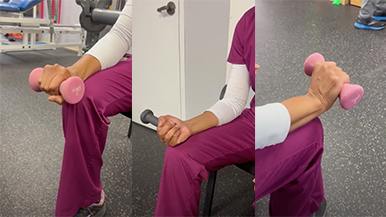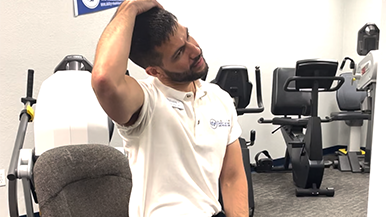- What is pelvic health?
- What are dyspareunia and vaginismus?
- What are some other conditions caused by pelvic health dysfunction?
- What to expect during your first pelvic health exam?
Sandi Smith, PT, and Ashley Kiely, PT, are pelvic health therapists and part of the Pelvic Physical Therapy Program with Ability Rehabilitation. They are just two of the excellent clinicians available to help you heal. As pelvic health specialists, Sandi and Ashley treat multiple conditions stemming from conditions in this area of the body.
What is pelvic health? What conditions fall into this category and how can a physical therapist help?
What Is Pelvic Health?
Pelvic health refers to the management of male and female reproductive organs. It’s part of a whole-body approach to embrace physical and mental health. The subset of physical therapy that treats issues affecting our pelvic health has been around for more than 40 years.
The pelvic health area of practice for physical therapists was founded by Elizabeth Noble, through the American Physical Therapy Association (APTA). Today there are more than 3,700 practitioners of this arm of the health sciences. These specialists treat:
- Anal spasms
- Coccyx (tailbone) pain
- Constipation/slow transit digestion
- Interstitial cystitis
- Low back, hip and sacroiliac (SI) joint pain
- Organ prolapse
- Overactive bladder
- Painful intercourse
- Pelvic floor tightness
- Pelvic floor weakness and incontinence
- Pelvic pain syndrome
- Pregnancy and postpartum conditions
The pelvic floor in the body plays an important role in the body by supporting the bladder, colon, rectum, and sex organs. The muscles in your pelvic floor help contract and relax your bladder and rectum for elimination. These muscles also contract during sexual intercourse to create a positive experience. If these muscles are not functioning well, there are a host of uncomfortable symptoms that can occur. Two conditions tied to the health of your pelvic area are dyspareunia and vaginismus.
What Are Dyspareunia and Vaginismus?
Dyspareunia and vaginismus are medical conditions that cause painful intercourse. Dyspareunia causes pain during sexual activity. Vaginismus causes involuntary spasm of the muscles in the lower part of the vagina. Vaginismus can cause dyspareunia to occur.
Sandi Smith says, “At least 30% of women experience painful intercourse during the course of their lives, and we really suspect the number is actually much higher than this.” She continues, “Now, due to social media and pelvic health therapy becoming more popular, this condition is finally getting some much-deserved attention.”
Researchers don’t fully understand what causes dyspareunia and vaginismus to occur. Sandi says, “In the past, it was often suggested it was all in your head. Although being anxious and fearful can contribute to tightness in the pelvic floor, more often than not, it is simply a set of muscles that needs proper stretching.”
Some of the factors that may contribute to vaginismus include:
- Anxiety disorders
- Fear of sex
- Injuries from childbirth
- Prior pelvic surgery
The symptoms of dyspareunia and vaginismus include:
- Muscle spasms that make it difficult or impossible to have sex or a pelvic exam
- Pain or discomfort during vaginal penetration, whether for sex or even to insert a tampon
Physical therapy for dyspareunia and vaginismus includes:
- Proper stretching
- Relaxation
- Manual treatments
Sandi says, “This treatment is similar to treating other muscles in the body that have become tight from over or under use.” Each patient will go home with a treatment plan designed for their specific situation.
“The best news of all,” Sandi says, “is that it can and most often does improve, leading to a better quality of life, an improved sense of self-esteem, intimacy, and happiness.”
What Are Some Other Conditions Caused by Pelvic Health Dysfunction?
Constipation, particularly when chronic, isn’t often considered a typical PT diagnosis. However, pelvic health PT may help with:
- Guidelines for food choices
- Patient education on digestive health
- Proper relaxation and stretching
- Self-care techniques
Sandi says, “Oftentimes the pelvic floor muscles are tight, contributing to poor elimination. This is a condition that can improve considerably with the expertise of a pelvic floor specialist.”
There are three types of bladder incontinence:
- Stress incontinence is caused by exercise or even sneezing
- Urge incontinence is accompanied by an urgency to go—now
- Mixed incontinence combines both of these symptoms
Incontinence, which is the inability to control bowel and bladder functions, is also often associated with the pelvic health muscles. One in three women and most men after prostate removal experience incontinence.
Ashley Kiely says, “Pelvic floor rehabilitation can help address these issues by improving pelvic floor muscle strength, coordination, power, and endurance.” Treatment of this condition by a pelvic floor PT includes:
- Breathing patterns
- Coughing patterns
- Education on lifestyle changes
- Instruction on key goals for the treatment
What to Expect During Your First Pelvic Health Exam
Sandi says, “Seeing a pelvic health PT begins with a basic orthopedic evaluation and examination of the pelvic floor muscles. It typically does involve an internal exam that is performed without the use of a speculum used by OB/GYNs.” The exam is always geared toward the individual comfort level of each patient.
Your physical therapist will learn more about your symptoms during this visit. You may undergo certain movements and exercises to determine the strength and coordination of your pelvic floor muscles. This could include:
- Biofeedback to check the contraction of your pelvic floor muscles
- Electrical stimulation to ease muscle spasms and pelvic pain
- Kegels to relax and contract the pelvic floor muscles
- Trigger point therapy that puts pressure on the body to loosen tight muscles
Each patient receives a home exercise plan to continue the good work to improve your health at home. Treatment plans are highly individualized because everyone’s healthy journey is different, but you can count on having both internal and external therapies designed to strengthen your pelvic floor and alleviate the symptoms you’re having. The goal is to ease symptoms so that you can get back to your normal routine.
Sandi says, “Seeing a pelvic health therapist includes being educated about your condition and your body, leaving you with a new sense of empowerment and comfort.”
If you’re struggling with any of the conditions we’ve discussed in this article, Ability Rehabilitation can help. Contact us online today or call us at 407-688-0070.



